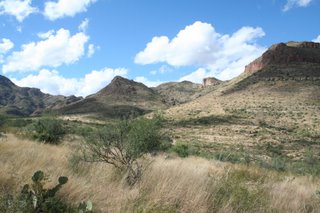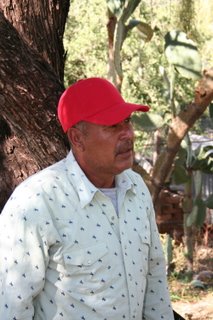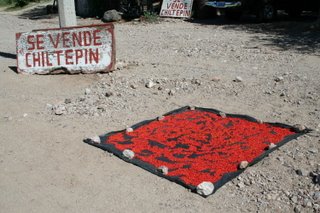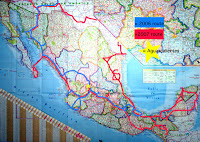Over the next few days we headed north each morning on dusty roads into the lands of the Guaijiro, one of the smallest of the 7 indigenous tribes of Sonora. The Guaijiro pick and harvest chiltepin during this time of year to supplement their cattle-based/small farm incomes. At each little town that we came to we were told that , oh yes, there are chiltepin in these mountains, but they’re not near here, they’re “mas alla” - with emphatic gestures to the mountains further to the north. Poco a poco, with various guides on different days, we managed to collect samples from nearly 30 plants – some of which were 4 hours from Alamos, accessed by a one-lane-rock-strewn-goat-trail.
Wednesday, October 25, 2006
Semi-Squatting in Alamos: Chiltepin, Scorpions and Vaqueros
Over the next few days we headed north each morning on dusty roads into the lands of the Guaijiro, one of the smallest of the 7 indigenous tribes of Sonora. The Guaijiro pick and harvest chiltepin during this time of year to supplement their cattle-based/small farm incomes. At each little town that we came to we were told that , oh yes, there are chiltepin in these mountains, but they’re not near here, they’re “mas alla” - with emphatic gestures to the mountains further to the north. Poco a poco, with various guides on different days, we managed to collect samples from nearly 30 plants – some of which were 4 hours from Alamos, accessed by a one-lane-rock-strewn-goat-trail.
Posted by
Kraig
7
comments
![]()
![]()
Thursday, October 19, 2006
The Cult of Chiltepine - in AZ and Sonora
 Last Saturday, I went to the Tumacacori Mountains in Arizona , with T., a postdoc at the University of Washington, to visit his field site - the Wild Chile Botanical Reserve. In this extreme landscape, filled with cacti, brambles, mesquite and hackberry, we hiked into arroyos and found chiltepin plants in the shade of trees and rocks. The plants were totally laden with fruit, as the area had been subject to an unsually strong summer monsoon season and since this was a "reserve" and relatively unknown, there was no one harvesting the fruits. On the high plateaus, where there was little drainage, we didn't encounter many chiles - but this was a different story in the small drainages, where we would often find 5 or 6 individuals within a short distance of each other. I sampled about 20 plants overall and left with the promise of more seeds from T., should I need them...
Last Saturday, I went to the Tumacacori Mountains in Arizona , with T., a postdoc at the University of Washington, to visit his field site - the Wild Chile Botanical Reserve. In this extreme landscape, filled with cacti, brambles, mesquite and hackberry, we hiked into arroyos and found chiltepin plants in the shade of trees and rocks. The plants were totally laden with fruit, as the area had been subject to an unsually strong summer monsoon season and since this was a "reserve" and relatively unknown, there was no one harvesting the fruits. On the high plateaus, where there was little drainage, we didn't encounter many chiles - but this was a different story in the small drainages, where we would often find 5 or 6 individuals within a short distance of each other. I sampled about 20 plants overall and left with the promise of more seeds from T., should I need them... A couple of days later, in the Valle de Rio Sonora, where the local baseball team is called "The Chiltepineros" and no meal complete without some of the red, round BB sized fruit at the table, Heather and I followed the hand drawn map to the small town of Mazocahui, where we found the infamous Luis selling chiltepin on the curve depicted on the yellow piece of legal pad. Luis was thrilled that someone sent us his way and that we were here to learn about chiltepin in the area. Chiltepin is sold by the side of the road, sold by volume, at about 10 dollars a liter. This is a real bargain compared to the 5 dollars for an ounce I paid in Tuscon! This time of year, folks are out the in the hills, collecting the fruit, drying them and selling them. For many people, this is a significant portion of their yearly income and a good harvest can bring some disposable income to the family. The following day, Luis led us through the landscape of Mazocahui as we collected the fruit of 25+ plants from the river bottom of the Rio Sonora to the slopes of the range that line the valley below. These plants were fairly similar compared to the population in Arizona - except for one plant, which had orange fruit. We're heading to Alamos to continue our quest...
A couple of days later, in the Valle de Rio Sonora, where the local baseball team is called "The Chiltepineros" and no meal complete without some of the red, round BB sized fruit at the table, Heather and I followed the hand drawn map to the small town of Mazocahui, where we found the infamous Luis selling chiltepin on the curve depicted on the yellow piece of legal pad. Luis was thrilled that someone sent us his way and that we were here to learn about chiltepin in the area. Chiltepin is sold by the side of the road, sold by volume, at about 10 dollars a liter. This is a real bargain compared to the 5 dollars for an ounce I paid in Tuscon! This time of year, folks are out the in the hills, collecting the fruit, drying them and selling them. For many people, this is a significant portion of their yearly income and a good harvest can bring some disposable income to the family. The following day, Luis led us through the landscape of Mazocahui as we collected the fruit of 25+ plants from the river bottom of the Rio Sonora to the slopes of the range that line the valley below. These plants were fairly similar compared to the population in Arizona - except for one plant, which had orange fruit. We're heading to Alamos to continue our quest...


Posted by
Kraig
2
comments
![]()
![]()




